Examining Norway’s Crucial Place in European Energy Security
The discovery of the Ekofisk oil field on the Norwegian Continental Shelf (NCS) in 1969 and the subsequent start of production from the field in 1971 heralded the rise of Norway’s Energy sector.1 Only a few years later, European energy security came to the forefront as a key concern as the 1973 Oil Crisis severely hampered European economies, and highlighted the need for secure energy sources.
In 2022, Europe once again finds itself in the throes of an energy crisis, as it reassesses its reliance on Russia for oil and gas. Germany estimates the impact could be a potential decrease of $240 billion in German economic output over the course of two years should Russian oil and gas be suddenly cut off.2 Unlike the 1970s, today Norway is not only an established exporter of oil and gas but also a leader in the adoption of clean energy. As Brussels mulls over various responses to climate change amid war in Ukraine, Norway’s role in fortifying European energy security should become even more important than it already is.
Oil and Gas Sector Transformed Norway’s Economy
Norway’s oil and gas sector is so significant to the country’s economy, that to get a sense of the impact the sector has, analysts typically look at Norway’s Mainland GDP as a barometer of economic growth, since this metric removes the oil and gas sector from the GDP calculation.3 Below we can see a timeline of how Norway’s energy sector has grown in the past decades.
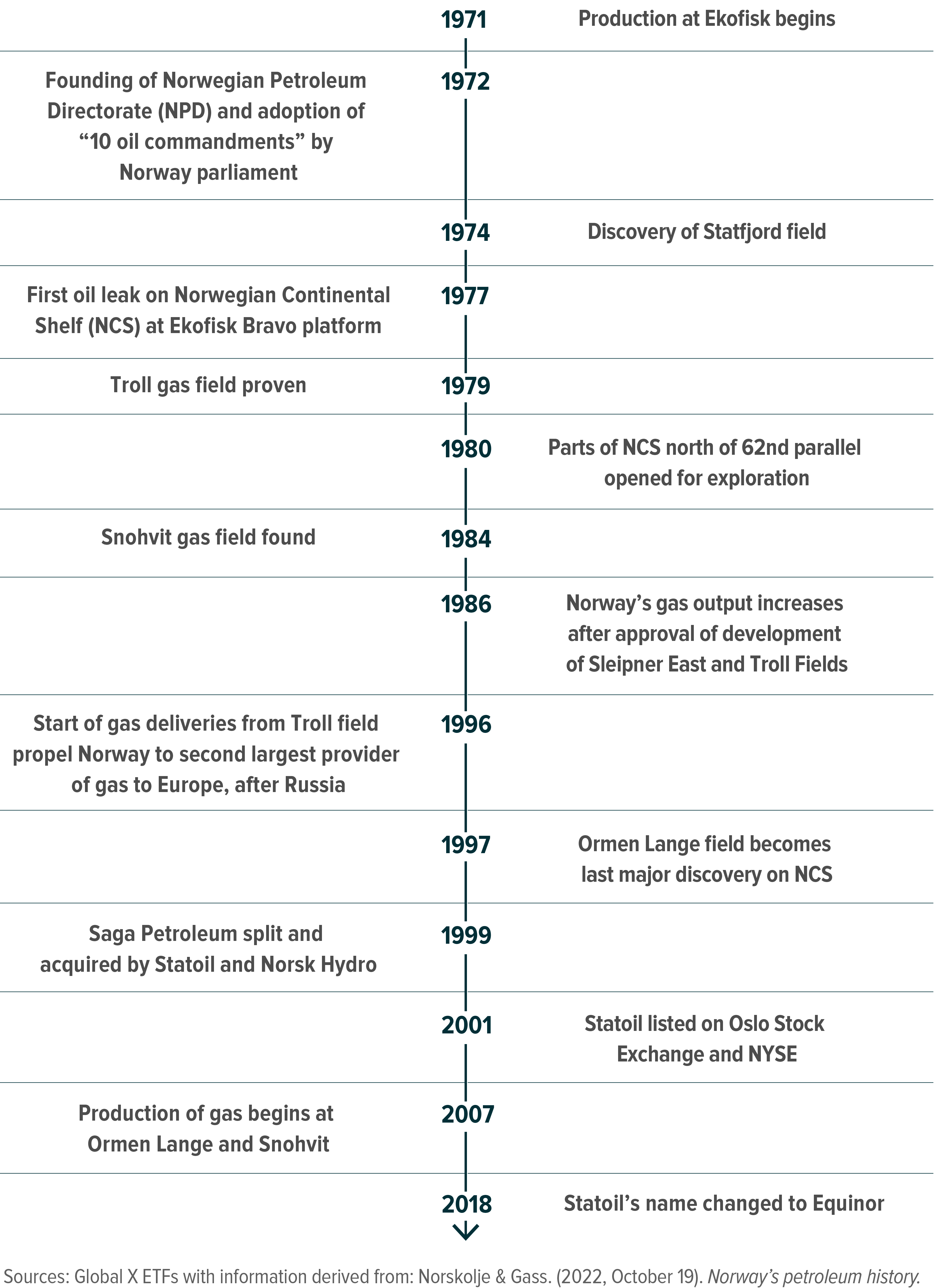
In the 1990’s and 2000’s, Norway consolidated its position as a major exporter of energy. Norway continued building out gas pipelines to Continental Europe and oil production peaked out at the turn of the century. By around 2010, gas production from the NCS surpassed oil production, and Norway became the second largest supplier of gas to Europe after Russia.4
The Norwegian government’s push to build the nation’s energy sector helped create an ecosystem of domestic Energy companies. These efforts paid off, as 8.21% of the MSCI Norway Index today is in Energy as of Jul 5, 2022.5
The state-owned giant Statoil gave Norwegian construction and engineering firms like Aker Solutions a nudge forward by considering them for projects. Meanwhile, Norway’s strong foundation in the shipping and shipbuilding industries that extends back to the 1800’s gave it a comparative advantage in establishing firms to build subsea infrastructure.6 For example, the underwater infrastructure builder Subsea 7 was formed as a joint-venture by an American company and DNSD, a Norwegian shipbuilding company founded in 1854.7
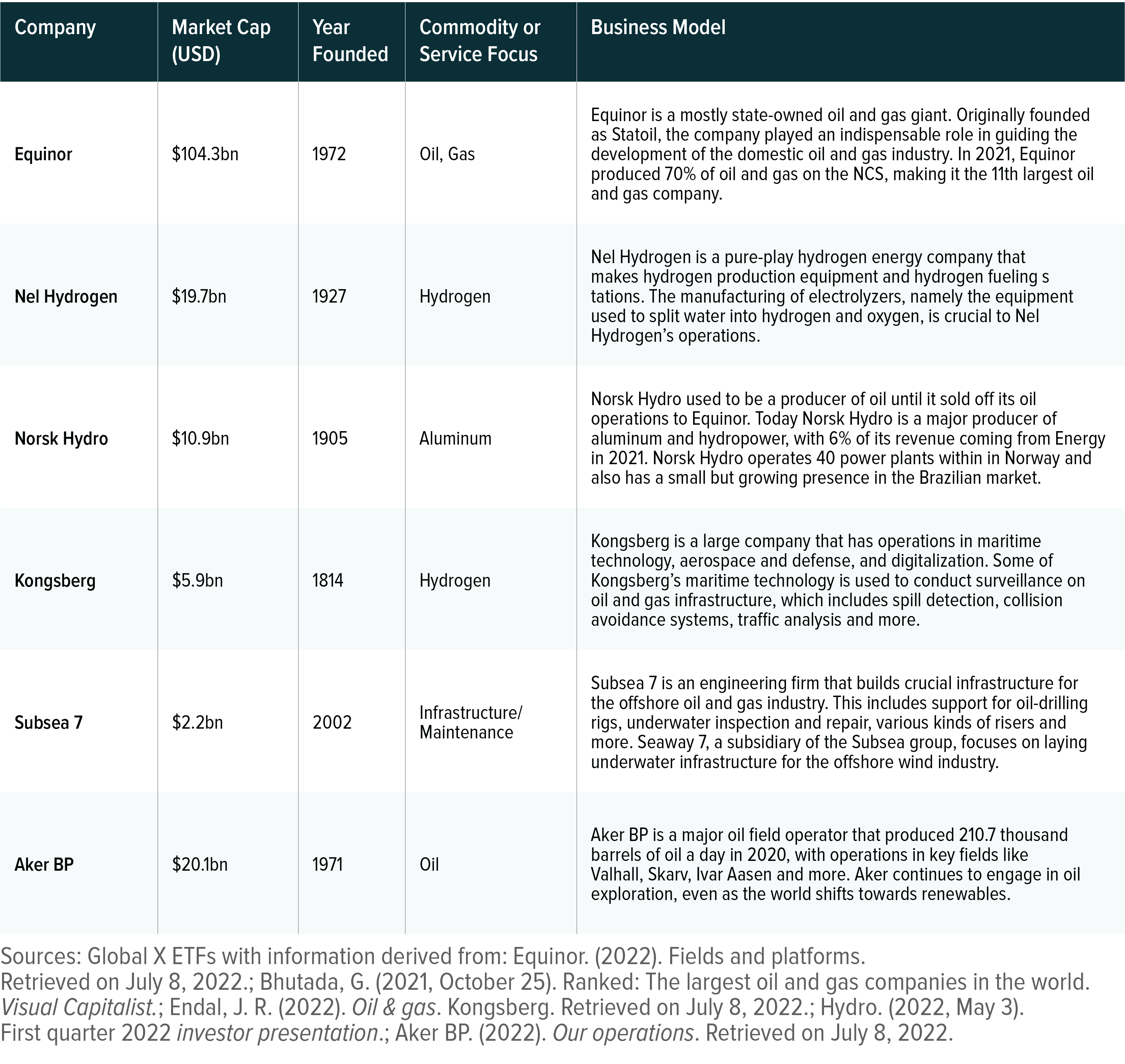
As Norway’s Energy ecosystem took shape, the stream of revenue from oil and gas led to the creation of a massive fund that now enjoys global fame. Norway’s oil and gas wealth is managed for future generations in the country’s sovereign wealth fund, the Government Pension Fund Global (GPFG), which is sustained through deposits of oil revenue and government surpluses. Because of restrictions that allow the government to spend no more than the fund’s expected return, the market value of the fund expanded from $18.3bn in 1998 to $1.3tn as of the end of 2021.8 In fact, the GPFG holds roughly 1.5% of all shares in the world’s listed companies.9
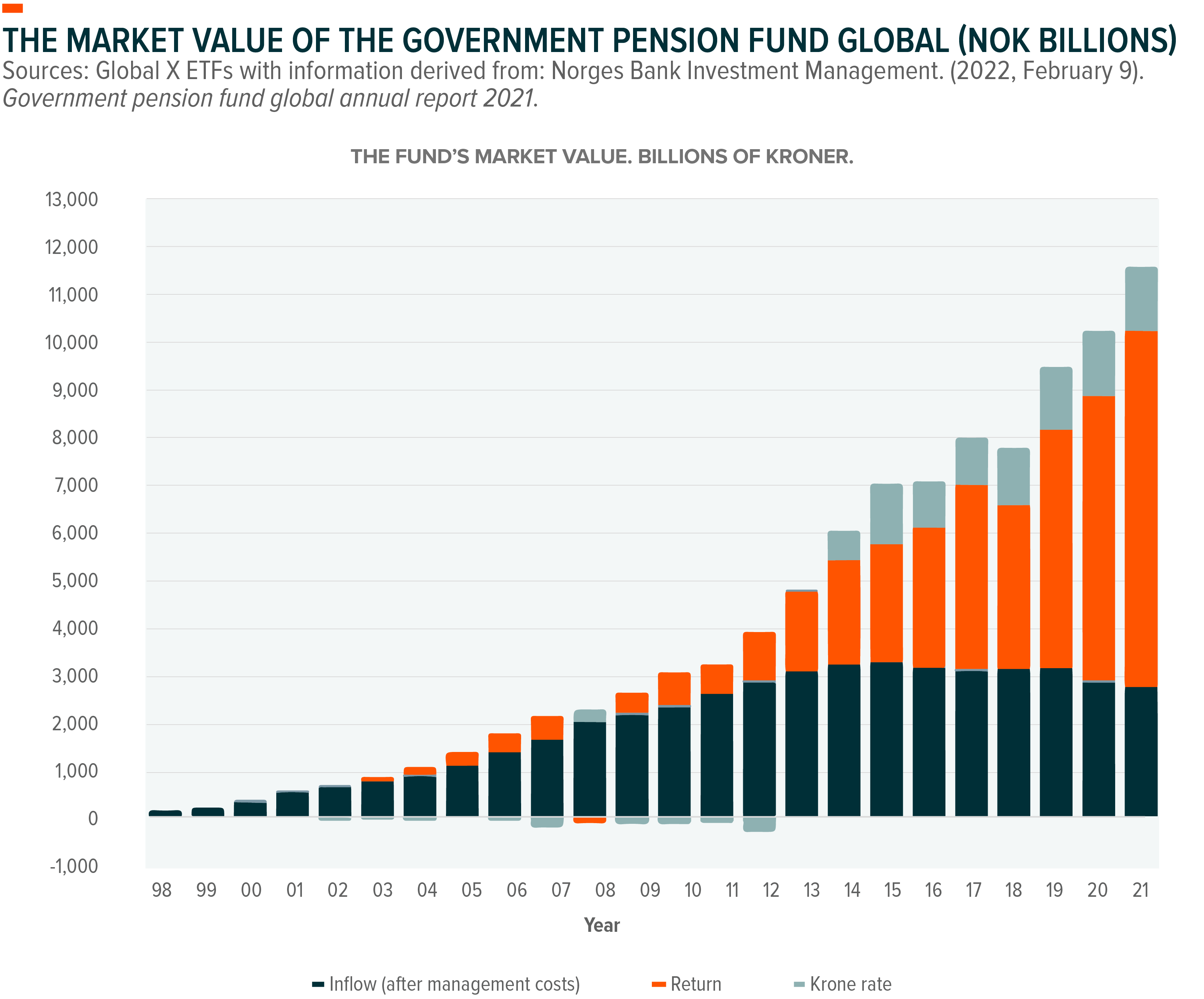
Europe Depends on Norwegian Oil and Gas
Energy supply routes in Europe are intermeshed across many borders, and EU member states depend on imports for oil and gas, with Russia and Norway serving as crucial suppliers. In 2021, 39.2% of the EU’s natural gas imports came from Russia while 25.1% came from Norway, and 24.8% of the EU’s oil imports came from Russia against 9.4% from Norway.10 Between 1990 and 2020, the combined energy import dependency ratio, namely the proportion of energy that must be imported, of the 27 countries that now make up the EU increased from 50% to 57.5%, and 16 of those countries had energy import dependency ratios over 50% as of 2020, including major economies like Germany, Italy, and Spain.11
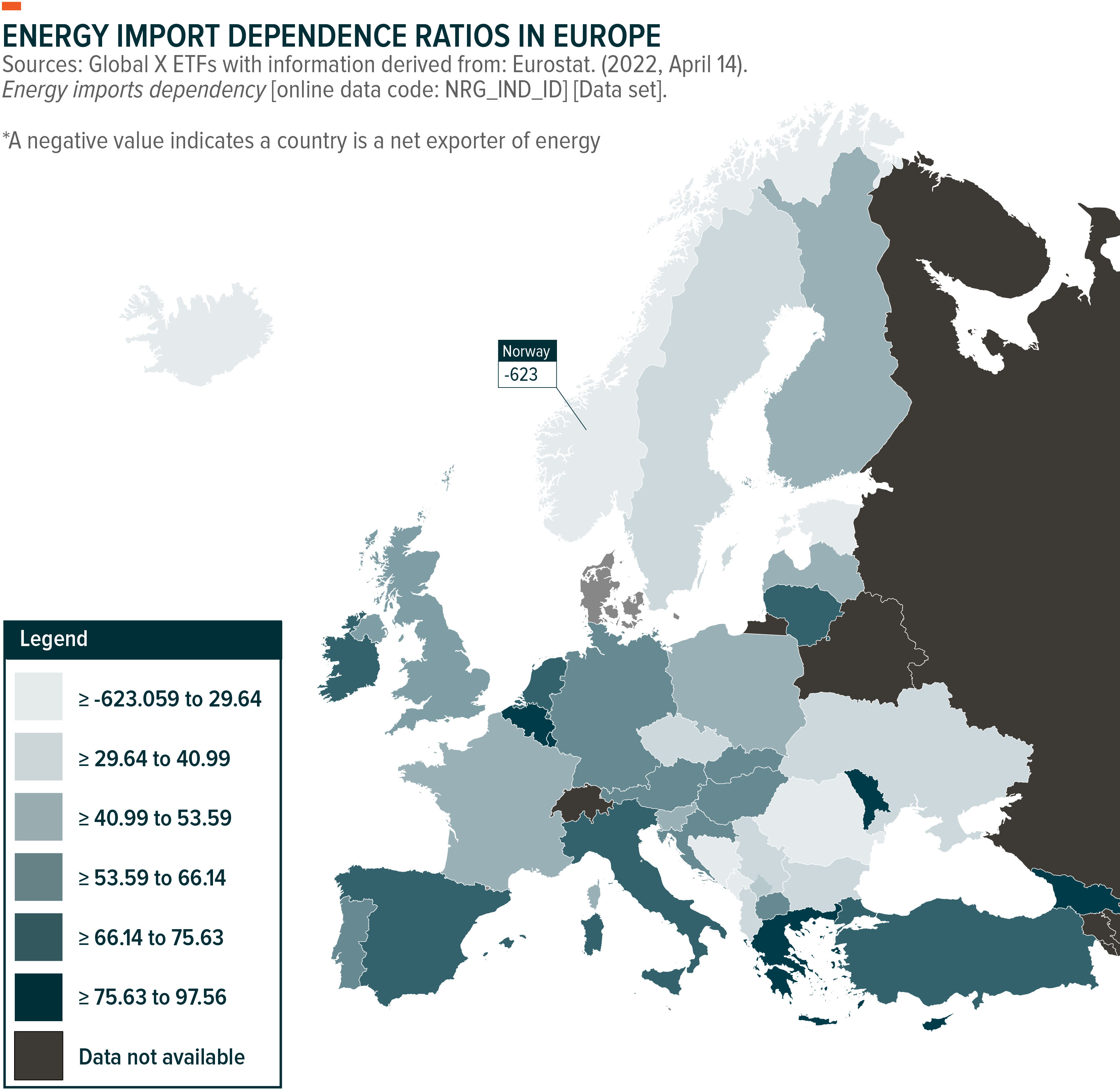
Although not a member of the EU, Norway is closely aligned with its EU neighbors and is a member of the European Economic Area. This relationship combined with Norway’s leadership in the Energy sector makes it a valuable contributor to European energy supply. Oil and gas made up 21% of Norway’s GDP and 51% of total exports in 2021, underscoring the intertwined relationship between the EU and Norway.12 Norway supplied 21% of the EU’s gas needs in 2020.13
Ten Norwegian gas pipelines are connected to Europe, with direct links to Germany, Belgium, France and the United Kingdom. Norway also has one oil pipeline connected to the United Kingdom, namely Norpipe Oil which was opened in 1975.14 The relative ease of transporting oil makes direct pipeline links less necessary. As of May 2022, a pipeline from Norway to Poland is under construction.15 Norway is also the only country in Europe aside from Russia to have an Liquified-Natural Gas (LNG) export terminal, and Norway is aiming to continue expanding its presence in the LNG space.16

Within Norway’s Energy sector, Equinor is an indispensably important actor. Formerly known as Statoil, Equinor is now among the largest companies in the world and is the second largest supplier of gas to Europe.17 In addition to sending gas and oil to Europe, in recent years Equinor is eyeing hydrogen energy as a key avenue for long-term growth in the European market.
Energy Crisis Looms Over Europe Amid Green Transition and Sanctions
In February 2022, Russia’s invasion of Ukraine ignited a geopolitical firestorm in Europe. Policymakers faced a conundrum, as Russia is the biggest supplier of gas to Europe. Leveling sanctions against Russia could result in a precipitous drop in Russian energy imports needed to sustain economic activity across Europe. The lion’s share of the natural gas consumed by the EU comes from Russia, which accounted for 45% of gas imports as of 2021.18 Therein lies the main reason for the energy crisis.
Several major incidents dating back to 1973 prompted Europe to reassess its energy security. In 1973, the Organization of Petroleum Exporting Countries (OPEC) launched an oil embargo that targeted a list of countries including the Netherlands and Portugal.19 In 2006 and 2009, the Russian company Gazprom restricted or shut off gas flows through Ukraine, creating economic pain for Europe.20
By 2014, the sense of urgency for Europe only compounded after Russia invaded and annexed the Crimean Peninsula in Ukraine. Sanctions led by the US and the EU targeted Russia’s long-term oil projects and skirted restrictions on natural gas altogether, specifically because the latter would plunge Europe into an energy crisis.21 Despite these geopolitical tensions, the laying of the Nord Stream 2 pipeline which ran underwater in the Baltic Sea directly from Russia to Germany began in 2018.
What sets apart the 2022 crisis is it is a hot conflict between two sovereign nations that is dragging on for months. To European policymakers, the need for some form of action is clear.
The sanctions the EU leveled against Russian Energy, as of Jun 1, 2022, include but are not necessarily limited to:
- Stopping Russian oil imports by sea
- Stopping Russian coal imports by Aug 2022
- Halting the Nord Stream 2 pipeline
- Reducing gas imports by two-thirds before Mar 202322
Norwegian Energy Sector Firing on All Cylinders
As Europe braces for a likely painful energy transition, Norway is in a position to help cushion the impact. On the policy side, Norway’s government began increasing the permitted amount of gas extraction as early as Sep 2021, in response to rising fuel prices.23 In 2021, rising oil and gas prices contributed to unusually high profits for Energy sector companies not only in Norway but throughout Europe.24 Therefore, the pressure facing these companies is not manifesting itself on the balance sheet, but rather out on the gas field where new ways of boosting output must be tried as a short-term solution to the crisis.
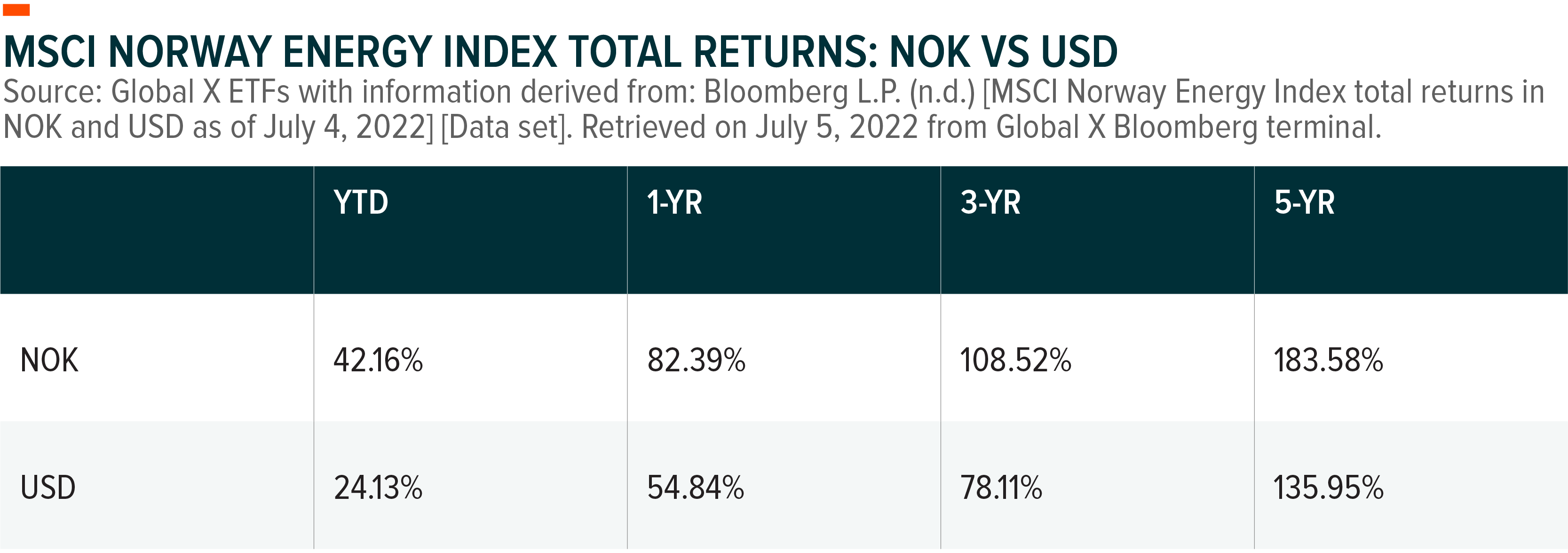
The largest company in the Norwegian Energy sector, namely Equinor, is naturally playing a key role in these efforts. In October 2021, Equinor started exporting gas that normally would have been reinjected into the Gina Krog field, and in early February 2022, the company stated that it was running at full capacity.25,26 On some fields, the company began turning down oil production in favor of gas production, in part because the methods of transportation for oil are more flexible than for gas.
After Russia’s invasion of Ukraine, the need for Equinor to pump out gas only increased. What was considered full capacity in February is no longer enough. In March 2022, Equinor announced that it rescheduled maintenance operations and was working to secure special permits to ensure production can reach even higher levels in 2022.27 Europe’s efforts to wean off of Russian gas could last until 2024, depending on the country.
Other Norwegian Energy companies are also gearing up for the seismic shift in Europe’s Energy landscape. Norwegian regulators gave Aker BP the green light to export 2 to 3 billion cubic meters of extra gas per year from the Skarv field. Just like with Equinor’s Krog field, under normal circumstances this extra gas would have been injected back into the ground.28 Nel Hydrogen, on the other hand, is positioned to contribute in a different way after it signed REPowerEU in March 2022 with the European commission and other European hydrogen companies. Made in response to the urgent need to decouple from Russian gas, the declaration aims for a tenfold increase in electrolyser manufacturing capacity and 10mn tons of renewable hydrogen energy by 2030.29 Nel Hydrogen is already working on the process of site selection for new production facilities in Europe.
In the short-term, efforts by Equinor and Aker BP should have the largest impact. Among these two companies, Equinor will likely have much more sway as its production overshadows Aker BP, with 79.5bn NOK (Norwegian Krone) turnover for oil and gas extraction compared to 3.7bn NOK for Aker BP, as of 2020.30 Over the long-term, Nel Hydrogen will stand to benefit as hydrogen energy capacity is increased while firms like Subsea 7 can benefit from the build-out of not only oil and gas infrastructure but perhaps more importantly offshore wind infrastructure.
In Jul 2022, Norwegian oil and gas workers at Equinor launched a strike for higher wages to match inflation, resulting in three oilfields shutting down on day one of the strike.31 Uncertainty remains as the situation is still unfolding at the time of writing, but the government and Equinor will likely move towards quick resolution, given the urgent need for gas in Europe.
Renewables Are Another Potential Path for Norwegian Energy Leadership
Ensuring a steady supply of gas to Europe is a crucial solution in the short-term, but in the long-term more possibilities open up with renewables. Norway’s oil and gas supply will not last indefinitely, which policymakers are cognizant of. That is part of the reason why Norway pushes harder than most other countries to adopt clean energy. Unique to Norway is that the GPFG empowers the country to do so at a speed unmatched by the rest of the world.
In 2020, electric vehicles (EV) made up an astonishing 75% of all new car sales in Norway, dwarfing Iceland’s 45%, the second highest share in the world.32 Generous tax incentives paid for by the GPFG made the rapid rise in EV adoption possible, and although other countries may not be able to replicate the GPFG model, Norway’s experience in adopting EV’s can be useful to reference and could potentially become a tool for Norwegian diplomacy.33
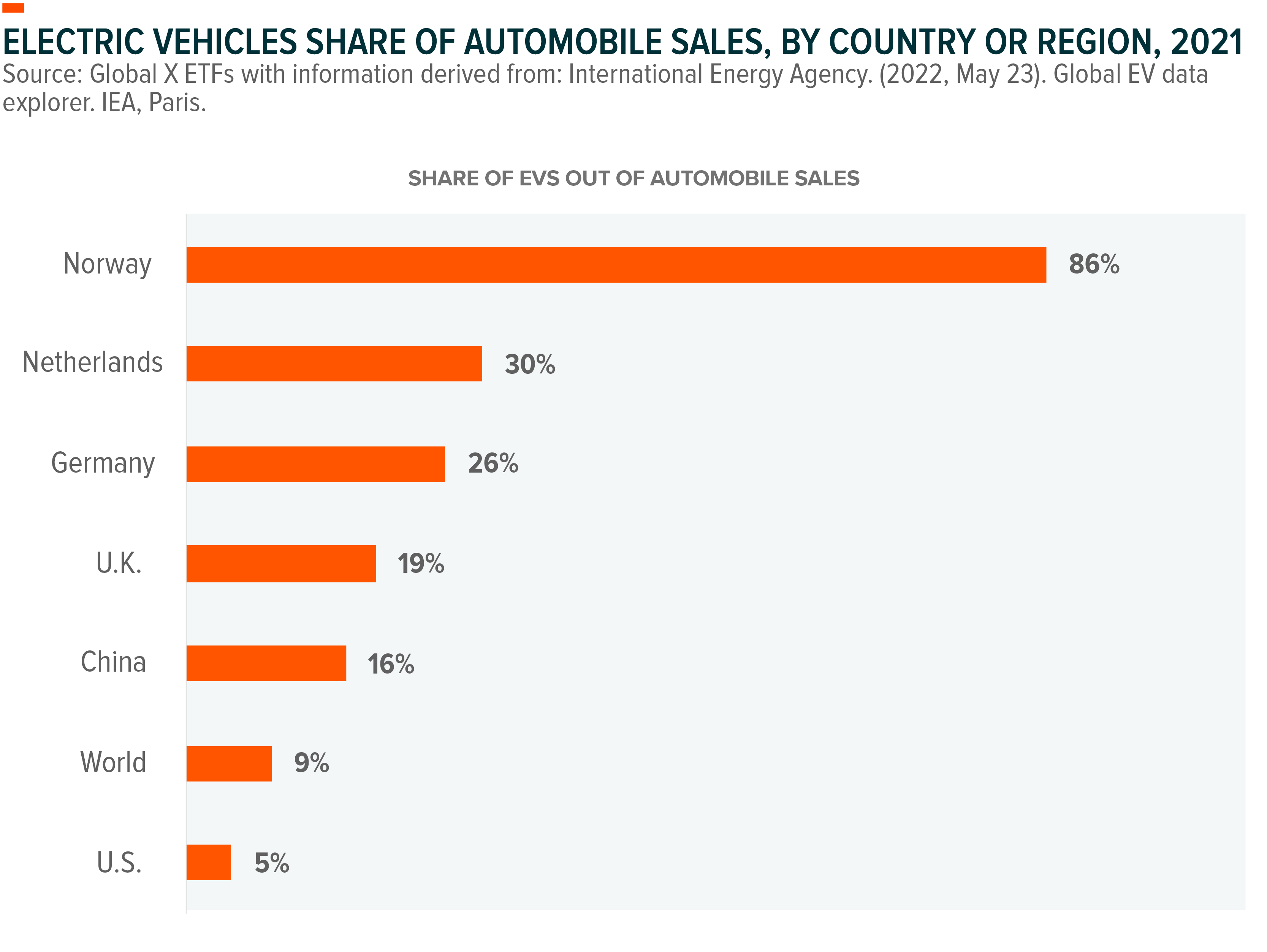
More directly relevant to the unfolding crisis is joint projects that will enable Norway to export clean energy to European neighbors. In Mar 2022, Norway and Germany opened up Nordlink, a direct power cable that will allow Norway to export green energy to Europe, and Norway already has similar cables connected to Denmark and the Netherlands.34 Over the long-term, as Norway builds out its renewables capacity and as Equinor transitions to more environmentally friendly sources of revenue, these connections will enable Norway to continue contributing to European energy security.
Conclusion
The forces of geopolitics and climate change are converging upon Europe and leaving it in an energy conundrum. After relying on Russia for almost half of its gas needs in 2021, Europe must now make an abrupt transition to energy sourced from other countries. At the same time, the challenges presented by climate change are moving forward unabated. We believe Norway is well-positioned to act as a stabilizing pillar as Europe embarks on the dual transition towards energy independence and clean energy. Norwegian Energy companies in particular can play a crucial role in smoothing out short-term supply shocks, not only in oil and gas, but also in wind and hydrogen energy over the long-run. As Norwegian oil and gas producers move to meet the urgent needs of Europe over the next few years, engineering firms can prepare to build out the infrastructure needed for capacity increases while other Energy firms lend their experience in EVs, offshore wind and hydrogen power to Europe.
Related ETFs
NORW: The Global X MSCI Norway ETF invests in among the largest and most liquid Norwegian securities.
Click the fund name above to view current holdings. Holdings are subject to change. Current and future holdings are subject to risk.



